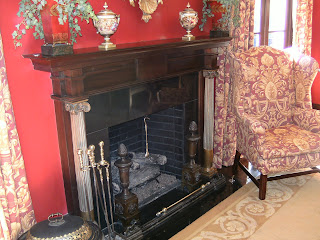I say this has come full circle because in the eighteenth century, for example, architects held full sway over the arrangement of furnishings in the public spaces of their extremely sculptural architectural creations. Versailles Palace is a case in point with arrangements of console table followed by chair followed by console table lined up like soldiers along the corridors as a sort of movable architecture designed to set off the pilasters. Then there are the state bedrooms that were pure stagecraft and from which the assigned residents would escape to more comfortable quarters as soon as the ceremonial part of going to bed was completed. The state rooms were the results of Design. The private apartments were decorated and the decorating -- as opposed to design -- reveal insights into the personalities of the occupants that the jaw-dropping opulence of the state rooms could never reveal.
Architects were slow to give up control of the interiors of their creations. A greater degree of the residential interior was given over during the nineteenth century partially as a result of the emerging middle class that could afford a draper and upholsterer to guide them through the design options, and partially because some women were raising their voices against house designs and furnishings that required exhaustive levels of housekeeping. By the turn of the twentieth century, the idea of an interior decorator was pretty well on its way toward being an acknowledged part of home design. Edith Wharton in conjunction with architect Ogden Codman, Jr. published The Decoration of Houses in 1897 which, among other things, strongly implies that taste is not subjective; the components of good taste can be identified and discussed objectively. Following the publication of Wharton’s book, the twentieth century saw the emergence of women as some of the most notable arbiters of good taste and inventive decorating trends. Dorothy Draper, Rose Cumming and Sister Parrish are but three whose influences are still felt. Yet, by the 1980s, decorators began to morph into designers. Why? I strongly suspect that many in the field lacked the inherent talent to become true decorators and so began the push for professional recognition and the title of designer because – truth be told: it is possible to teach the mechanics of design such as appropriate door placement for ADA compliance and correct widths on passage corridors. But you cannot teach scale or how to mix two patterns together successfully. You can teach color theory and discuss things in terms of warm and cool but you will never teach the talent that intuitively takes the minutest color found in an Oriental carpet to use as the trim color on an upholstered chair. It’s the difference between a professional illustrator and a talented artist. From one you will get a consistently satisfactory representation; from the other you will receive soul stirring imagery.
Some of the most beautiful work I have ever seen is the result of collaboration between a highly talented interior decorator and an inspired architect in which each is bringing the best available from his or her education and experience. The example I am including is the result of collaboration between the enormously gifted architect, Norman Davenport Askins, and the highly talented interior decorator, Marie B. Warren. The mantelpiece shown is the result of their joint efforts on a project from 1998. Mrs. Warren had seen the bronze fluted columns with the Ionic capitals in a shop a few years earlier. Having no immediate use for them, she found them to be inspiring and bought them to have on hand for when a suitable occasion arose. While working on this particular job, she and Norman Askins were brainstorming about how to develop the space that would ultimately become a combination library dining room. Askins introduced the notion of creating custom woodwork in mahogany from his own designs. Warren loved this idea and began to develop the color scheme that would ultimately settle on the red lacquer that is seen in the picture. Askins sent some initial drawings over to Warren that included the first draft of a mantelpiece based on a classical design including the columns – but in wood. Warren recalled the bronze columns she had kept stored for two years and sent them to Askins office.
 |
| Classical Mantelpiece: Norman D. Askins and Marie B. Warren |
Now, I am not saying that decorating is more or less important than designing. But I do say this: when you decide to bake a cake and you are considering how many people you need to serve and whether you want a sheet cake or a layer cake and whether it will be yellow cake or chocolate cake – you are probably designing the cake. But when you begin to decide to use white frosting to set off the appearance of the chocolate layers when the cake is sliced – or you decide to drizzle chocolate on the white icing – or you decide to make traditional pink and yellow swags and roses – you are clearly decorating the cake and in the end, what do you think people will remember: That your cake exactly served the precise number of people it was designed to serve? Or that it was beautifully decorated? My guess is the beauty, which is why I will always want my cakes (and my rooms) decorated rather than designed.
No comments:
Post a Comment